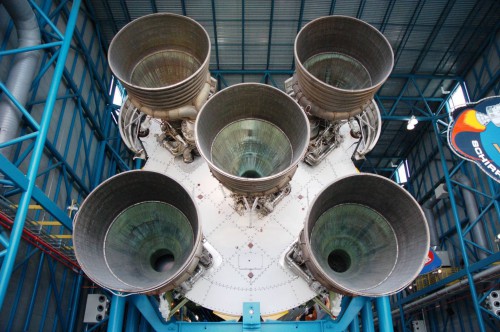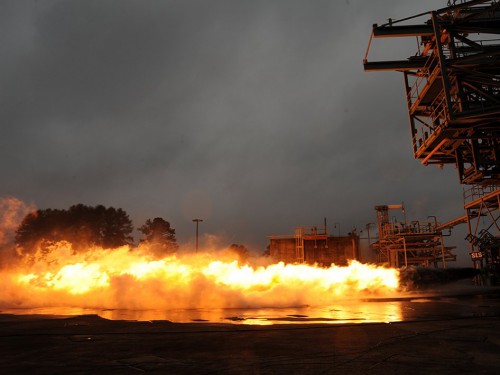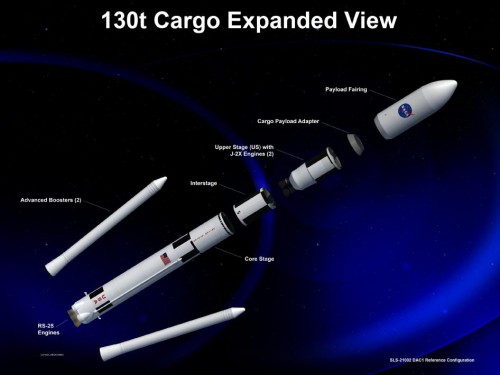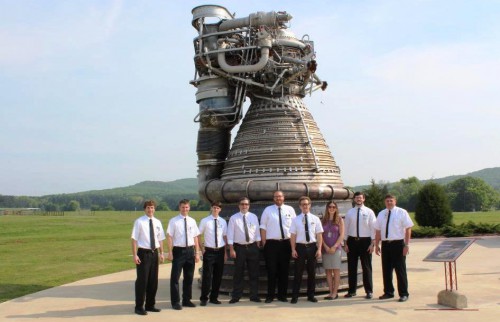
Five massive F-1 engines powered each Saturn V rocket into its place in history. These massive engines were instrumental in allowing NASA to win the race to the Moon and are now poised to make a comeback—in a major way.
A team of engineers working at NASA’s Marshall Space Flight Center in Huntsville, Ala. are studying the venerable F-1 for possible use in NASA’s new heavy-lift Space Launch System, or “SLS.”
Engineers from a wide range of disciplines have broken down components of the monster engine and refurbished them. The secrets gleaned from the engineers’ efforts will be put to use in NASA’s plans to send crews far beyond the orbit of Earth. It is hoped that lessons learned from the F-1 will give rise to advanced and innovative designs.

Researchers dismantled the F-1’s gas generator, which supplies power to the F-1’s turbopump. The gas generator is one of the first components of a rocket’s engine that is designed. The size of the gas generator often dictates the general size of the engine itself.
NASA’s requirements are hefty ones. The space agency’s SLS rocket will need to be capable of hefting 130-metric-ton (143-ton) payloads into orbit.
Two generators were “liberated” from F-1s located at Marshall and at the Smithsonian Air and Space Museum located in Washington D.C. The parts were cleaned and then scanned to create three-dimensional renderings of the components.
What researchers found was most enlightening. Similar components can be more affordably produced using modern machining techniques. Given the poor state of the U.S. economy, this is very welcome news.
Test Stand 116, located at MSFC East Test Area, has roared to fiery life under the refurbished fury of the gas generators.

Dynetics, Inc. and Pratt Whitney Rocketdyne have submitted a proposal to have two F-1 engines used in the SLS Block II design. These are fueled by liquid oxygen and rocket-fuel grade kerosene—not something engineers that worked on the space shuttle’s SSMEs (Space Shuttle Main Engine) are too familiar with, as the SSMEs ran off of liquid oxygen and liquid hydrogen.
A final determination of whether or not SLS will use these systems has yet to be made. Given the history and record of the F-1, a 21st variant could prove to be beneficial for NASA’s new heavy-lift booster.
Hoping for a little more background on the F-1? The following is an excerpt from Ben Evans’ ESCAPING THE BONDS OF EARTH:
Built by Rocketdyne, the F-1 engine—which burned a refined form of kerosene, known as “Rocket Propellant-1” (RP-1), with liquid oxygen—remains to this day the most powerful single-nozzled liquid engine ever used in service. Although it experienced severe teething troubles during development, notably through “combustion instability,” it would go on to become the cornerstone for a lunar landing capability.





I really find it wonderful that NASA is considering the reuse of the tested-and-true F-1 engines. There is a saying: ‘If it ain’t broken, then don’t try to fix it’. In this case: ‘If it works, and it works fine, then reuse it!’
Also Jason I have a question. Leaving political barriers aside, could a NERVA-type engine be used on the SLS in the future, as it was the hope for Saturn V in the past?
What’s “old, is new again.” By all means use the F-1. Cost savings plus proven technology equals jump-starting American manned spaceflight. We can’t afford not to do this.
Leonidas,
I haven’t heard anything (yet) about NERVA. As always, we try to highlight any new developments relating to SLS. If we do hear anything, stay tuned to AmericaSpace for updates.
Sincerely, Jason Rhian – Editor, AmericaSpace
I’m going to bet that the parts taken were from two F-1A’s.
http://www.spacelaunchreport.com/sls6.html
The F-1 was a great engine. But by 1965, Rocketdyne had come-up with several changes that could make the 1.5 M lbf thrust engine even more powerful. In 1967 two F-1A’s were built, tested, and crew-rated. Tests showed that the F-1A would generate just a hair under 1.8 M lbf of thrust. But by then, Congress was in no mood to fund production of the F-1A, to be incorporated into future Saturn V launches, as it already had plans to wind-down Apollo. There’s more info at,
http://www.astronautix.com/engines/f1a.htm
Another interesting thing is that the F-1A would allow the SLS booster to reach 130 mT without an upper stage. Add-in the upper-stage and the SLS becomes a 150 mT rocket, and the most powerful ever in all terms.
http://www.nasaspaceflight.com/2013/01/the-dark-knights-atks-advanced-booster-revealed-for-sls/
Of course, whether the F-1A becomes the advanced booster for the Block II SLS remains to be seen. ATK is making some really impressive improvements to the 5-segment solid motors that will power SLS Block I. The competition between Rocketdyne-Dynetics and ATK really will only benefit SLS and make it a better launcher. As for me, my money is on the F-1A for four reasons. First, it powered us to the Moon so it’s connection with NASA is special. It, like the ATK motor, is human-rated. The history between Marshall, the NASA center running the SLS program, and the F-1 is especially deep. And Sen. Richard Shelby, Marshall’s biggest promoter, is the Ranking Member of the full Senate Appropriations Committee, as well as his membership on the Appropriations Commerce, Justice, and Science Subcommittee.
Hi Jim,
Very good points.
Also keep in mind that work on the F1/F1-A engines date back 45 years. The Designs still exist, but many of the manufacturing techniques have changed (some assumed suppliers no longer exist). Therefore while such a new engine could be based on the F1/F1-A, it would be a new engine.
Good news to investigate bringing back the F-1 engine. What’s also interesting is such an engine used on a SLS-sized core could exceed the 70 mT payload of the SLS *without* side boosters IF the core stage was weight optimized by common bulkhead design and aluminum-lithium tanks:
http://exoscientist.blogspot.com/2012/06/low-cost-hlv-page-3-lightweighting-s-ic.html
Bob Clark